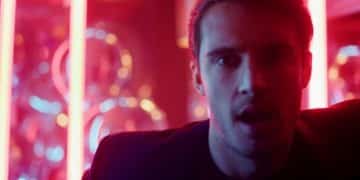Director’s Cut Dilemma: Are Extended Versions Really Better in 2025?

The director’s cut dilemma explores whether extended versions of movies truly enhance the viewing experience, analyzing if added scenes and alternate endings improve narrative depth or simply pad the runtime, a relevant question for movie lovers in 2025.
The cinematic world often presents us with choices, and one increasingly common option is whether to watch the theatrical release of a film or delve into the extended director’s cut dilemma: Are extended versions of movies really better? A 2025 analysis invites us to explore this question.
The Rise of the Director’s Cut
In recent years, the director’s cut has become a significant phenomenon in the film industry. No longer a rare curiosity, these extended versions are now frequently anticipated and debated by cinephiles and casual viewers alike. But what exactly fuels this trend?
Creative Control and Vision
Director’s cuts often represent the filmmaker’s original vision, untouched by studio interference or the constraints of theatrical runtime. This allows for a more complete and nuanced portrayal of the story.
Marketing and Fan Engagement
The release of a director’s cut provides a fresh marketing opportunity, generating buzz and engaging fans who are eager to experience a deeper dive into their favorite movies.

Here are some key elements driving the prevalence of director’s cuts:
- The desire of filmmakers to share their complete artistic vision.
- Increased availability through streaming and home entertainment.
- A growing audience appetite for more immersive and detailed storytelling.
- Strategic marketing by studios to re-engage viewers.
Ultimately, the increasing popularity of director’s cuts signals a shift in how we consume and appreciate cinema, one where the director’s voice carries more weight.
Understanding the Differences: Theatrical vs. Director’s Cut
The distinction between a theatrical release and a director’s cut can be subtle or significant, depending on the film. Often audiences wonder if the differences actually make the movie better.
Added Scenes and Extended Sequences
One of the most common features of a director’s cut is the inclusion of scenes that were cut from the theatrical version. These additions can provide greater context, character development, or thematic resonance.
Alternate Endings and Deleted Subplots
Some director’s cuts feature entirely different endings than the theatrical release, offering a new perspective on the story’s conclusion. Similarly, deleted subplots can be reinstated, enriching the narrative tapestry.
Consider these key differences when comparing the two versions:
- Pacing and rhythm: Director’s cuts often have a slower pace.
- Character arcs: Added scenes can enhance character depth and complexity.
- Thematic exploration: Director’s cuts may delve deeper into thematic elements.
- Overall tone: The director’s cut might have a different tone than the theatrical release.
Recognizing these distinctions helps viewers to better appreciate the specific nuances of each version and aids in determining whether the director’s cut truly enriches the original film.
Case Studies: Director’s Cuts That Elevated the Original
While not all director’s cuts are successful, some have undeniably improved upon the theatrical release. These examples demonstrate the creative potential of allowing filmmakers to fully realize their vision.
“Blade Runner: The Final Cut” (2007)
Ridley Scott’s “Blade Runner” had numerous versions, but the “Final Cut” is widely considered the definitive one. It eliminated voice-over narration and ambiguous elements, resulting in a darker, more philosophical film. This shows that sometimes, less truly is more. By removing parts of the theatrical release that he did not want, Scott ensured a legendary film.
“Kingdom of Heaven: Director’s Cut” (2005)
Ridley Scott again delivered with the director’s cut of “Kingdom of Heaven”. This version restored significant plot elements and character development, transforming a convoluted theatrical release into a sweeping epic.

“Daredevil: Director’s Cut” (2004)
The theatrical release of “Daredevil” was not a very good movie, but the director’s cut shows the world how much better it could have been. The director’s cut fixed many of the issues that haunted the theatrical release, turning it into a watchable action movie.
These success stories highlight the transformative power of director’s cuts when executed with a clear vision.
The Pitfalls: When Extended Doesn’t Mean Better
Despite the potential benefits, director’s cuts are not always an improvement. Sometimes, added scenes can disrupt the pacing, dilute the narrative, or simply feel unnecessary. More and more movies are getting director’s cuts, so many people expect it to be a positive now. However, it is not always a positive. This is why it is still appropriate to ask: Are extended versions of movies really better?
Pacing Issues and Narrative Bloat
Adding too much material can disrupt the established rhythm of a film, leading to a sense of bloat and diminishing the impact of key scenes. This is usually the case for director’s cuts that do not elevate or improve the original movie.
Unnecessary Additions and Redundancy
Sometimes, deleted scenes are best left on the cutting room floor. Their inclusion in a director’s cut may add little value, feeling repetitive or irrelevant to the overall story.
Here are warning signs that a director’s cut might not be worth the extra runtime:
- Poor pacing and a lack of narrative focus.
- Scenes that feel tangential or disconnected from the main plot.
- Redundant dialogue or exposition.
- A sense that the added material was cut for good reason.
By recognizing these potential drawbacks, viewers can critically assess whether a director’s cut enhances or detracts from the original film.
The Future of Director’s Cuts: A 2025 Perspective
Looking ahead to 2025, the role of director’s cuts in cinema is likely to evolve even further. Technological advancements and changing audience expectations will shape how these versions are created, distributed, and consumed. Only time will tell if they will be an improvement, though.
Streaming and On-Demand Access
The rise of streaming platforms has made director’s cuts more accessible than ever before. This trend is expected to continue, with streaming services potentially offering exclusive access to extended versions and behind-the-scenes content.
Interactive Viewing Experiences
Future director’s cuts may incorporate interactive elements, allowing viewers to customize their experience by choosing which scenes to include or explore alternate storylines. Some companies have introduced this concept already.
Consider these emerging trends:
- Personalized viewing experiences tailored to individual preferences.
- The use of AI to generate supplementary content, such as character backstories or alternate scenes.
- Closer collaboration between directors and audiences in shaping the final version of a film.
The future of director’s cuts is likely to be defined by greater interactivity and a more personalized approach to storytelling.
Making the Choice: Is the Director’s Cut Right for You?
Ultimately, the decision of whether to watch a director’s cut comes down to personal preference. There is no objective answer to whether or not they are worth it. Consider personal taste and what one hopes to get out of watching a film when deciding between the theatrical and director’s cut.
Consider Your Preferences
Do you enjoy a more leisurely pace and greater depth of character development? Or do you prefer a tightly edited and focused narrative? Your answer to these questions can help guide your choice.
Read Reviews and Seek Recommendations
Before diving into a director’s cut, research reviews and seek recommendations from trusted sources. This can provide valuable insights into the quality and value of the extended version.
Here are some guidelines to help you decide:
- If you loved the theatrical release and want to experience more of the same, a director’s cut might be a good choice.
- If you found the theatrical release confusing or incomplete, an extended version could provide greater clarity.
- However, if you were underwhelmed by the theatrical release, a director’s cut is unlikely to change your mind.
By carefully considering your preferences and doing your research, you can make an informed decision about whether to embark on the extended journey of a director’s cut.
| Key Point | Brief Description |
|---|---|
| 🎬 Director’s Vision | Director’s cuts often represent the filmmaker’s original, unfiltered vision. |
| ⏱️ Extended Scenes | Added scenes can provide greater context or character development. |
| 🤔 Pitfalls | Extended versions aren’t always better; pacing and relevance can suffer. |
| 🔮 Future Trends | Streaming and interactive features will shape future director’s cuts. |
FAQ
▼
A director’s cut is a version of a film that reflects the director’s original vision, often including scenes or edits that were removed from the theatrical release due to studio constraints or runtime considerations.
▼
Not necessarily. While some director’s cuts enhance the film by adding depth and context, others may disrupt the pacing or include unnecessary scenes that detract from the overall experience.
▼
Director’s cuts are often available on Blu-ray/DVD releases, streaming platforms, and through digital retailers like iTunes or Amazon Prime Video, depending on the film’s distribution rights.
▼
Read reviews and seek recommendations from trusted sources. Consider whether you enjoyed the original release and what you hope to gain from an extended version before making a decision.
▼
Yes, with the rise of streaming and personalized viewing experiences, director’s cuts are likely to remain a significant part of cinema, offering viewers a deeper and more customizable experience.
Conclusion
Ultimately, the debate surrounding the director’s cut dilemma: Are extended versions of movies really better? A 2025 analysis suggests that there is no easy answer. The value of a director’s cut depends on the specific film, the filmmaker’s vision, and individual viewer preferences. As technology continues to shape the cinematic landscape, these extended versions offer both exciting opportunities and potential pitfalls, inviting us to engage with cinema in new and dynamic ways.





